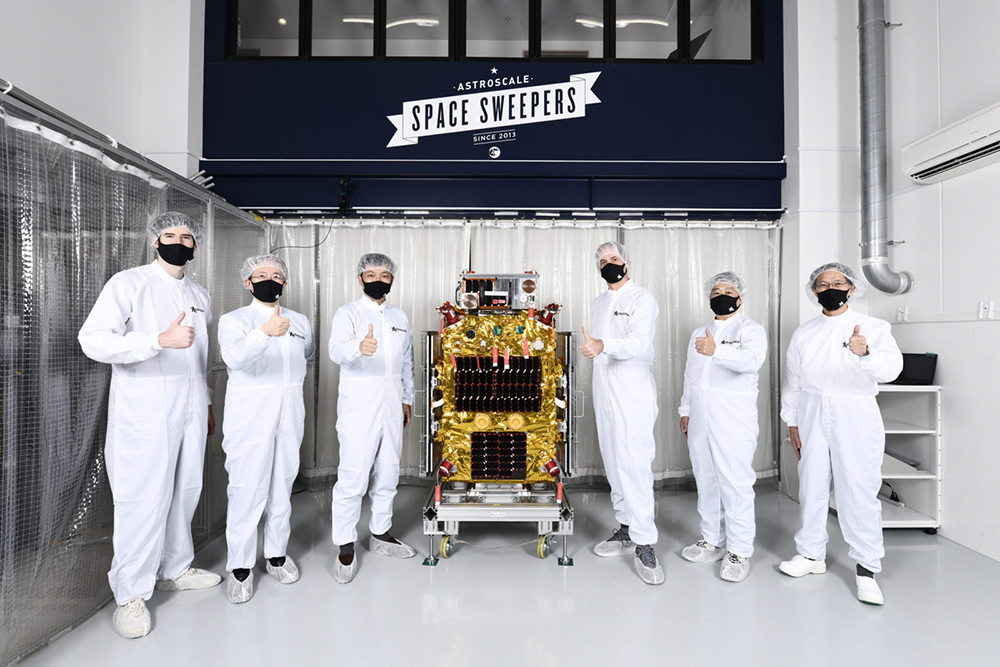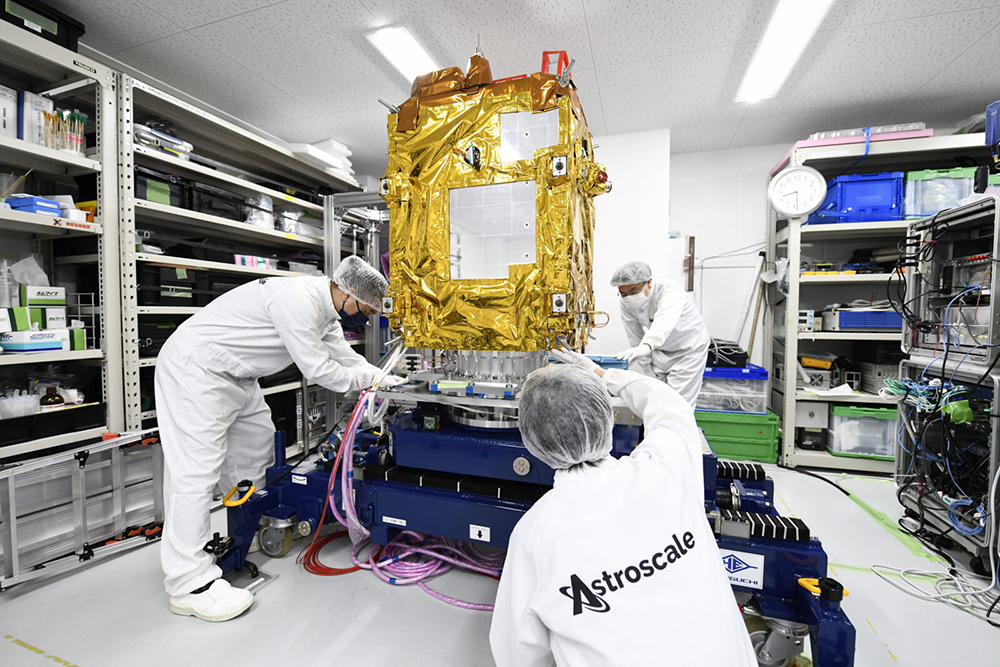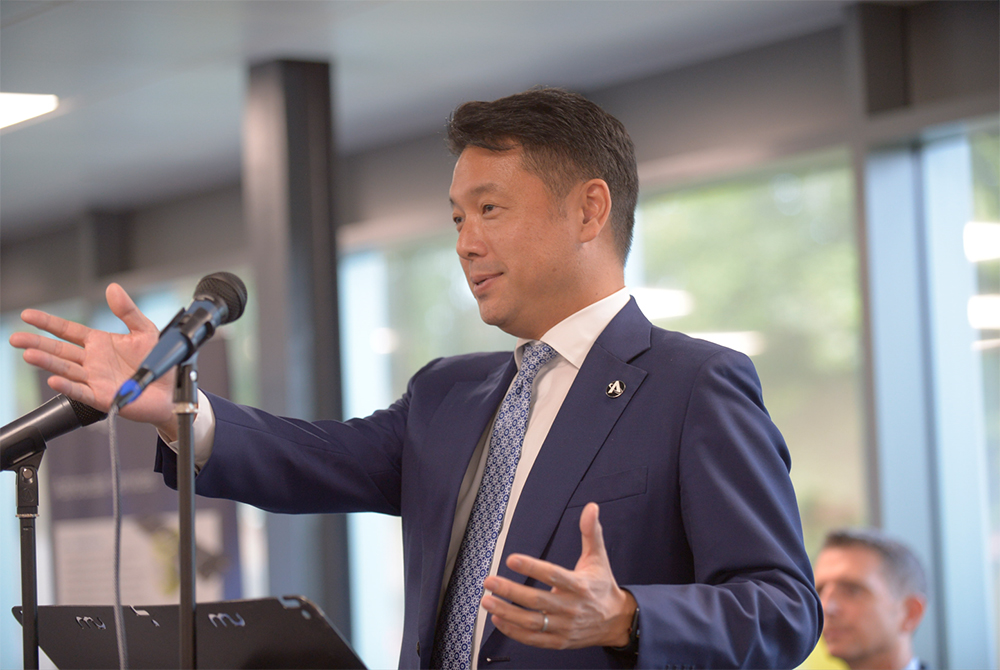他去太空清理垃圾,商业成功还解决了中年危机
 Astroscale的管理层与ELSA-d卫星合照,该卫星发射于2021年。左三为公司创始人兼首席执行官冈田光信。图片来源:ASTROSCALE
Astroscale的管理层与ELSA-d卫星合照,该卫星发射于2021年。左三为公司创始人兼首席执行官冈田光信。图片来源:ASTROSCALE冈田光信是日本科技界一位成功的企业家,曾创办一家IT公司,后又作为首席财务官带领另外一家IT公司上市。但2013年,在40岁的不惑之年,他发现自己陷入了典型的中年危机。“我总是想,等我40多岁、50多岁时应该做些什么?我曾经认为自己算得上商业上的领跑者,但我的信心突然消失了,”他说。
冈田在找回激情的过程中想到了自己十几岁时参加美国宇航局太空营的回忆,他喜欢极了。他说:“我想,我也许应该在航天业重燃激情。”后来他参加了几次太空行业的会议,2013年4月,他去德国参会,意识到太空碎片带来的与日俱增的危险已经成为航天业等待解决的热门话题。一周后,他成立了自己的初创公司Astroscale,自此筹集了3亿美元资金,今年9月和瑞士航天初创公司ClearSpace一起拿到了英国航天局(UKSA)440万美元的合同,要设计一个2025年把两艘航天器从轨道上移除的任务。
“2013年,我意识到太空碎片已经让太空环境变得不可持续。当时没有人能提出解决方案。”冈田说,“这就是我创办Astroscale的原因,因为清除太空碎片不仅是商业机会,也是保护环境的必要之举。”
太空垃圾的问题大约在13年前进入了公众视野。2009年2月10日,一颗报废的俄罗斯卫星Kosmos 2251与一颗正在运行的美国通信卫星Iridium 33相撞,Iridium被摧毁,这是已知的世界上首次人造卫星与太空垃圾的碰撞。
据美国宇航局估计,此次撞击产生了近2000块碎片,是所谓的凯斯勒综合症的第一个例子。该理论由美国宇航局天体物理学家唐纳德·凯斯勒于1978年提出,认为到2000年,地球轨道上的碎片密度将足够高,以致于卫星开始会因为随机碰撞而解体,从而产生更多的碎片,撞碎更多的卫星,循环往复,“导致碰撞率和碎片数量呈指数级增长”。
凯斯勒关于卫星损毁会产生多米诺骨牌连锁效应的预言还没有实现,但有令人担忧的迹象表明,这一天即将到来。2020年,卫星与碎片之间近距离擦肩而过——即不到一公里的距离——的几率为每月2000次,或每天70次。Astroscale的冈田说,到2021年,这个数字增加了两倍,达到每月6000次。

“这太可怕了,”冈田说。“太空物体的密度已经达到了临界水平。”
市场研究公司北方天空研究公司(NSR)的太空分析师侯赛因·博哈里表示,冈田的Astroscale公司是第一家专门针对太空碎片成立的商业实体。现在,Astroscale在商业太空服务行业面临大量竞争,NSR估计,未来10年,该行业的收入将达到143亿美元。
从油漆点到公交车
根据欧洲航天局的数据,目前约有8850颗卫星绕地飞行,而且这个数字每天都在增加。根据瑞士主营太空垃圾收集的创业公司ClearSpace的创始人兼首席执行官卢克·皮圭的说法,地球每年大约向太空发射1000颗卫星。2021年,仅SpaceX公司就发射了800颗星链(Starlink)卫星。弗罗斯特沙利文咨询公司(Frost & Sullivan)的全球太空主管朱莉•霍尔特•琼斯表示,目前在轨的卫星中,已经有2000多颗不再运转。但最大的问题不在于卫星本身,而在于它们周围的碎片。
地球轨道上有15000到18000个“大”碎片——大小从10厘米(垒球的直径)到一辆城市公交车不等。NSR的博哈里说,还有20万到23万件1到10厘米的碎片。
即使是最小的粒子也会带来很大的风险。“即使是油漆斑点大小的小碎片,在这么高的运转速度下,也会造成巨大破坏。”霍尔特·琼斯说,“我不知道你看没看过电影《地心引力》,”她说的是2013年乔治·克鲁尼和桑德拉·布洛克主演的电影,讲述的是一架航天飞机被困在凯斯勒综合症碎片区的故事。“这不是部写实电影,但它凸显了空间碎片潜在的破坏。”
自从欧空局开始进行追踪以来,已经记录了630起“导致碎裂的解体、爆炸、碰撞或异常事件”。确定相撞的责任,或者强迫公司将不再服役的卫星移出轨道几乎是不可能的。太空的管理依照的依然是1967年签订的联合国条约。霍尔特·琼斯说:“那里有点像狂野西部。”
“危险在于轨道上的物体和碎片会大量增加,以至于这些轨道无法再使用。”Astroscale的首席运营官克里斯•布莱克比表示:“15年后回头看,我们会把决定采取措施维护轨道干净的这一天看成是分水岭,只有这样轨道还能为我们的子子孙孙继续使用。如果我们不这么做,就得为此向后代道歉。”
磁铁,机械臂,还有鱼叉
卫星和碎片最终会落回地球。皮圭说,一颗位于地球上空500公里处的报废卫星——星链的卫星就是这个高度——将在5年内坠落,而一颗位于600公里处的报废卫星可能需要25年,700公里处的卫星则需要一个世纪。
理论上说,为了加快这个过程,碎片清理卫星可以抓取碎片或报废卫星,再通过减速并将其拖到较低的高度来降低其轨道。
但现实中还存在许多复杂的因素。首先,在近地轨道( 2000公里以下)的物体运行速度非常快:每秒7-8公里。其次,残骸和报废卫星不会主动告知它们的位置,所以很难找。第三,许多碎片,比如火箭助推器,在飞行过程中会旋转。
“轨道上的物体现在还没有准备好被捕获。它们没有对接接口。它们没有用来牵引的挂钩,”皮圭说。
为了捕捉不合作的太空猎物,一些初代设计包括网和鱼叉,就像RemoveDEBRIS项目设计的那样,可以成功捕获它带入到太空中的小物体。
但现在拥有340名员工的Astroscale采取了不同的方法。该公司与OneWeb(仅次于星链的全球第二大卫星网络)和Altius Space Machines(一家航空硬件公司)合作,开发了一种对接板系统,该系统可以让Astroscale的航天器用磁铁捕获OneWeb卫星,再将其拖到大气层中烧掉。Astroscale公司的ELSA-d宇宙飞船去年已经成功发射并捕获了一个测试物体。

展望未来,Astroscale与日本航天局签订了一份合同,将发射一艘航天器对一节上面级火箭进行检查,为以后拆卸这节火箭做准备;2024年,它将发射ELSA-M航天器,为OneWeb从轨道上移除一个物体。
ClearSpace则是从瑞士洛桑理工学院的工作中分离出来的。2009年,在那里,一组科学家将一颗小型立方体卫星(CubeSat,常被大学用于实验)发射到Iridium/Kosmos 碎片区,并在2012年意识到碎片问题已经发展到必须要解决的地步。

但这支由ClearSpace联合创始人穆里尔·理查德领导的团队对此一开始并没有什么兴趣。皮圭说,大伙的反应是,“谁会想要清洁太空? 没人会为这种东西付钱的。这背后没有任何商业机会。” 当像OneWeb这样的公司开始获得发射数百颗新卫星的融资时,行业的商业前景发生了变化,ClearSpace 于2018年应运而生。
ClearSpace已经筹集了500万美元的股权融资,拥有80名员工,正在开发一种四臂机器人航天器,可以抓取卫星和碎片。 到2025年,作为与欧洲航天局签署的8600万欧元(8400万美元)服务合同的一部分,ClearSpace将发射ClearSpace-1来移除一个112公斤的上面级火箭部件。作为英国宇航局与Astroscale公司签订的440万美元合同的一部分,ClearSpace公司将设计一项任务,从轨道上移除两个在英国注册的废弃物体。

Astroscale还在为以后的任务开发机器人手臂。
最终,空间碎片清理公司的目标是提供全方位服务的空间服务公司,用冈田的话说,就是能够“回收、再利用、修复、补充燃料和清除”空间飞行器的公司。
“我的目标是,到2030年,我想让在轨服务成为常规工作,成为太空中维持其可持续发展的日常工作。”他说,“我们只剩下8年时间了。” (财富中文网)
译者:Agatha
冈田光信是日本科技界一位成功的企业家,曾创办一家IT公司,后又作为首席财务官带领另外一家IT公司上市。但2013年,在40岁的不惑之年,他发现自己陷入了典型的中年危机。“我总是想,等我40多岁、50多岁时应该做些什么?我曾经认为自己算得上商业上的领跑者,但我的信心突然消失了,”他说。
冈田在找回激情的过程中想到了自己十几岁时参加美国宇航局太空营的回忆,他喜欢极了。他说:“我想,我也许应该在航天业重燃激情。”后来他参加了几次太空行业的会议,2013年4月,他去德国参会,意识到太空碎片带来的与日俱增的危险已经成为航天业等待解决的热门话题。一周后,他成立了自己的初创公司Astroscale,自此筹集了3亿美元资金,今年9月和瑞士航天初创公司ClearSpace一起拿到了英国航天局(UKSA)440万美元的合同,要设计一个2025年把两艘航天器从轨道上移除的任务。
“2013年,我意识到太空碎片已经让太空环境变得不可持续。当时没有人能提出解决方案。”冈田说,“这就是我创办Astroscale的原因,因为清除太空碎片不仅是商业机会,也是保护环境的必要之举。”
太空垃圾的问题大约在13年前进入了公众视野。2009年2月10日,一颗报废的俄罗斯卫星Kosmos 2251与一颗正在运行的美国通信卫星Iridium 33相撞,Iridium被摧毁,这是已知的世界上首次人造卫星与太空垃圾的碰撞。
据美国宇航局估计,此次撞击产生了近2000块碎片,是所谓的凯斯勒综合症的第一个例子。该理论由美国宇航局天体物理学家唐纳德·凯斯勒于1978年提出,认为到2000年,地球轨道上的碎片密度将足够高,以致于卫星开始会因为随机碰撞而解体,从而产生更多的碎片,撞碎更多的卫星,循环往复,“导致碰撞率和碎片数量呈指数级增长”。
凯斯勒关于卫星损毁会产生多米诺骨牌连锁效应的预言还没有实现,但有令人担忧的迹象表明,这一天即将到来。2020年,卫星与碎片之间近距离擦肩而过——即不到一公里的距离——的几率为每月2000次,或每天70次。Astroscale的冈田说,到2021年,这个数字增加了两倍,达到每月6000次。
“这太可怕了,”冈田说。“太空物体的密度已经达到了临界水平。”
市场研究公司北方天空研究公司(NSR)的太空分析师侯赛因·博哈里表示,冈田的Astroscale公司是第一家专门针对太空碎片成立的商业实体。现在,Astroscale在商业太空服务行业面临大量竞争,NSR估计,未来10年,该行业的收入将达到143亿美元。
从油漆点到公交车
根据欧洲航天局的数据,目前约有8850颗卫星绕地飞行,而且这个数字每天都在增加。根据瑞士主营太空垃圾收集的创业公司ClearSpace的创始人兼首席执行官卢克·皮圭的说法,地球每年大约向太空发射1000颗卫星。2021年,仅SpaceX公司就发射了800颗星链(Starlink)卫星。弗罗斯特沙利文咨询公司(Frost & Sullivan)的全球太空主管朱莉•霍尔特•琼斯表示,目前在轨的卫星中,已经有2000多颗不再运转。但最大的问题不在于卫星本身,而在于它们周围的碎片。
地球轨道上有15000到18000个“大”碎片——大小从10厘米(垒球的直径)到一辆城市公交车不等。NSR的博哈里说,还有20万到23万件1到10厘米的碎片。
即使是最小的粒子也会带来很大的风险。“即使是油漆斑点大小的小碎片,在这么高的运转速度下,也会造成巨大破坏。”霍尔特·琼斯说,“我不知道你看没看过电影《地心引力》,”她说的是2013年乔治·克鲁尼和桑德拉·布洛克主演的电影,讲述的是一架航天飞机被困在凯斯勒综合症碎片区的故事。“这不是部写实电影,但它凸显了空间碎片潜在的破坏。”
自从欧空局开始进行追踪以来,已经记录了630起“导致碎裂的解体、爆炸、碰撞或异常事件”。确定相撞的责任,或者强迫公司将不再服役的卫星移出轨道几乎是不可能的。太空的管理依照的依然是1967年签订的联合国条约。霍尔特·琼斯说:“那里有点像狂野西部。”
“危险在于轨道上的物体和碎片会大量增加,以至于这些轨道无法再使用。”Astroscale的首席运营官克里斯•布莱克比表示:“15年后回头看,我们会把决定采取措施维护轨道干净的这一天看成是分水岭,只有这样轨道还能为我们的子子孙孙继续使用。如果我们不这么做,就得为此向后代道歉。”
磁铁,机械臂,还有鱼叉
卫星和碎片最终会落回地球。皮圭说,一颗位于地球上空500公里处的报废卫星——星链的卫星就是这个高度——将在5年内坠落,而一颗位于600公里处的报废卫星可能需要25年,700公里处的卫星则需要一个世纪。
理论上说,为了加快这个过程,碎片清理卫星可以抓取碎片或报废卫星,再通过减速并将其拖到较低的高度来降低其轨道。
但现实中还存在许多复杂的因素。首先,在近地轨道( 2000公里以下)的物体运行速度非常快:每秒7-8公里。其次,残骸和报废卫星不会主动告知它们的位置,所以很难找。第三,许多碎片,比如火箭助推器,在飞行过程中会旋转。
“轨道上的物体现在还没有准备好被捕获。它们没有对接接口。它们没有用来牵引的挂钩,”皮圭说。
为了捕捉不合作的太空猎物,一些初代设计包括网和鱼叉,就像RemoveDEBRIS项目设计的那样,可以成功捕获它带入到太空中的小物体。
但现在拥有340名员工的Astroscale采取了不同的方法。该公司与OneWeb(仅次于星链的全球第二大卫星网络)和Altius Space Machines(一家航空硬件公司)合作,开发了一种对接板系统,该系统可以让Astroscale的航天器用磁铁捕获OneWeb卫星,再将其拖到大气层中烧掉。Astroscale公司的ELSA-d宇宙飞船去年已经成功发射并捕获了一个测试物体。
展望未来,Astroscale与日本航天局签订了一份合同,将发射一艘航天器对一节上面级火箭进行检查,为以后拆卸这节火箭做准备;2024年,它将发射ELSA-M航天器,为OneWeb从轨道上移除一个物体。
ClearSpace则是从瑞士洛桑理工学院的工作中分离出来的。2009年,在那里,一组科学家将一颗小型立方体卫星(CubeSat,常被大学用于实验)发射到Iridium/Kosmos 碎片区,并在2012年意识到碎片问题已经发展到必须要解决的地步。
但这支由ClearSpace联合创始人穆里尔·理查德领导的团队对此一开始并没有什么兴趣。皮圭说,大伙的反应是,“谁会想要清洁太空? 没人会为这种东西付钱的。这背后没有任何商业机会。” 当像OneWeb这样的公司开始获得发射数百颗新卫星的融资时,行业的商业前景发生了变化,ClearSpace 于2018年应运而生。
ClearSpace已经筹集了500万美元的股权融资,拥有80名员工,正在开发一种四臂机器人航天器,可以抓取卫星和碎片。 到2025年,作为与欧洲航天局签署的8600万欧元(8400万美元)服务合同的一部分,ClearSpace将发射ClearSpace-1来移除一个112公斤的上面级火箭部件。作为英国宇航局与Astroscale公司签订的440万美元合同的一部分,ClearSpace公司将设计一项任务,从轨道上移除两个在英国注册的废弃物体。
Astroscale还在为以后的任务开发机器人手臂。
最终,空间碎片清理公司的目标是提供全方位服务的空间服务公司,用冈田的话说,就是能够“回收、再利用、修复、补充燃料和清除”空间飞行器的公司。
“我的目标是,到2030年,我想让在轨服务成为常规工作,成为太空中维持其可持续发展的日常工作。”他说,“我们只剩下8年时间了。” (财富中文网)
译者:Agatha
Nobu Okada was a successful tech entrepreneur in Japan—the founder of one IT company and the CFO who led another to its IPO. But when he turned 40 in 2013, he found himself in a classic midlife crisis. “I was wondering, What should I do during my forties or fifties? I had felt like I was a kind of front-runner in business, but all of a sudden I lost confidence,” he says.
Looking to rekindle his passion, Okada recalled how he loved attending a NASA Space Camp in the U.S. as a teenager. “I thought it might be the space industry where I should ignite my passion again,” he says. He went to several space conferences and, while attending one in Germany in April 2013, discovered that the growing danger of space debris was the industry’s hot unsolved topic. A week later, he set up his startup Astroscale, which has since raised $300 million in funding and in September won a $4.4 million contract with the U.K. Space Agency (UKSA) alongside Swiss space startup ClearSpace to design a mission to remove two spacecraft from orbit in 2025.
“I realized in 2013 that space debris had already made the space environment unsustainable. And no one had a solution for the problem,” Okada says. “That’s why I started Astroscale, because removing space debris was not only a business opportunity, but also an environmental necessity.”
The problem of space junk entered public consciousness about 13 years ago. On Feb. 10, 2009, a defunct Russian satellite, the Kosmos 2251, collided with a working American communications satellite, the Iridium 33, destroying the Iridium and marking the world’s first recorded collision between a man-made satellite and a piece of space junk.
That crash produced almost 2,000 pieces of debris, according to NASA estimates, and was the first example of the so-called Kessler Syndrome. The theory, proposed in 1978 by NASA astrophysicist Donald Kessler, held that by 2000 debris in Earth’s orbit would be so dense that satellites would begin breaking up due to random collisions, creating more debris to break up more objects, and so on, “resulting in an exponential growth in the collision rate and debris population.”
Kessler’s theory of a cascading domino effect of satellite destruction hasn’t yet come to pass, but there are worrying signs that the day is approaching. In 2020, near misses between satellites and debris—that is, less than a kilometer of distance—occurred 2,000 times per month, or 70 times per day. They tripled in 2021, to 6,000 per month, says Astroscale’s Okada.
“It’s horrifying,” Okada says. “The density of objects in space has reached a critical level.”
Okada’s Astroscale was the first commercial entity founded to target space debris, says Hussain Bokhari, a space analyst at the market research firm Northern Sky Research (NSR). Now Astroscale has plenty of competition in the commercial space services industry that NSR estimates will earn $14.3 billion in revenue over the next decade.
From a fleck of paint to a city bus
About 8,850 satellites orbit earth today, according to the ESA, and that total is climbing on a daily basis. Earth is sending about 1,000 satellites into space every year, according to Luc Piguet, cofounder and CEO of ClearSpace, a Swiss startup that collects space junk. In 2021, SpaceX alone launched 800 Starlink satellites. Of the satellites currently in orbit, more than 2,000 no longer function, says Julie Holt Jones, the global lead for space at the consultancy Frost & Sullivan. But the problem isn’t the satellites as much as the debris around them.
The earth’s orbit contains 15,000 to 18,000 pieces of “big” debris—or objects that range from 10 centimeters, the diameter of a softball, to the size of a city bus. There are another 200,000 to 230,000 pieces between 1 and 10 centimeters, says NSR’s Bokhari.
Even the smallest particles pose a big risk. “You can have tiny fragments, the size of a fleck of a piece of paint, and they’re going at such high speed they can cause tremendous damage,” says Holt Jones. “I don’t know if you’ve ever seen the film Gravity,” she adds, referring to the 2013 George Clooney–Sandra Bullock film about a space shuttle caught by a Kessler Syndrome debris field. “It’s not realistic in all aspects, but it highlights the potential devastating effect of space debris.”
Since the ESA started keeping track, it has recorded 630 “break-ups, explosions, collisions, or anomalous events resulting in fragmentation.” Assigning responsibility for the collisions—or forcing companies to remove expiring satellites from orbit—is almost impossible. Space is still governed by a UN treaty from 1967. “It’s a bit like the Wild West up there,” says Holt Jones.
“The danger is a proliferation of objects and debris in orbit to the point where those orbits become unusable,” says Chris Blackerby, Astroscale’s COO. “We’re going to look back on this in 15 years and see this as a watershed moment where we’re taking the steps to make sure that these orbits are clean and remain usable for our children and their children. Or if we don’t, we’re going to be apologizing to future generations for messing it up.”
Magnets, robot arms, and harpoons
Satellites and debris fall back to Earth—eventually. A dead satellite at about 500 kilometers above earth—where Starlink’s satellites are—will fall in five years, says Piguet, while one at 600 kilometers might take 25 years and one at 700 kilometers a century.
To speed up the process, the theory goes, a debris-clearing satellite could grab a piece of debris or a dead satellite and degrade its orbit by slowing it down and dragging it to a lower altitude.
But there are many complicating factors. First, objects in low Earth orbit (LEO, under 2,000 kilometers) travel super fast: 7–8 kilometers a second. Second, debris and dead satellites don’t communicate their positions, which makes them hard to find. Third, many pieces of debris, like rocket boosters, rotate as they travel.
“The objects in orbit now are not prepared to be captured. They don’t have a docking interface on them. They don’t have a hook for towing,” says Piguet.
Early designs for capturing uncooperative space prey included nets and harpoons like those designed by the RemoveDEBRIS project, which successfully caught small objects it took into space.
But Astroscale, which now has 340 employees, took a different approach. Working with OneWeb, the world’s second biggest satellite network after Starlink, and Altius Space Machines, an aerospace hardware company, the firm developed a docking plate system that would allow Astroscale spacecraft to capture OneWeb satellites with a magnet and drag them down to burn up in the atmosphere. Astroscale’s ELSA-d spacecraft already successfully released and captured a test object last year.
Going forward, Astroscale has a contract with the Japanese space agency to launch a spacecraft to inspect an upper stage rocket in preparation for removing it later on; in 2024 it will launch its ELSA-M spacecraft to remove one object from orbit for OneWeb.
ClearSpace, for its part, spun out of work at EPFL, the Swiss Institute of Technology of Lausanne. There, a team of scientists sent a tiny CubeSat satellite (often used by universities for experiments) into the Iridium/Kosmos debris field in 2009 and realized, in 2012, the debris problem had grown enough that it needed to be addressed.
But the team, led by ClearSpace cofounder Muriel Richard, found little interest at first. The reaction was, “Who would ever want to clean space? Nobody will ever pay for something like this. There’s no business case behind it,” Piguet says. That outlook changed when companies like OneWeb began receiving funding to send up hundreds of new satellites, and ClearSpace launched in 2018.
ClearSpace, which has raised $5 million in equity funding and employs 80 people, is developing a four-armed robot spacecraft that will grab satellites and debris. In 2025, as part of an €86 million ($84 million) service contract it signed with the European Space Agency (ESA), ClearSpace is set to launch ClearSpace-1 to remove a 112-kilogram upper-stage rocket part. And as part of the $4.4 million UKSA contract it shares with Astroscale, ClearSpace will design a mission to remove two U.K.-registered derelict objects from orbit.
Astroscale is also developing a robot arm for later missions.
In the end, the goal for space debris removal companies is to become full services space service firms that, in Okada’s words, can “recycle, reuse, repair, refuel, and remove” space objects.
“My goal is, by 2030, I want to make in-orbit servicing just routine work, a daily job in space to make it sustainable,” he says. “We just have only eight years to go.”













